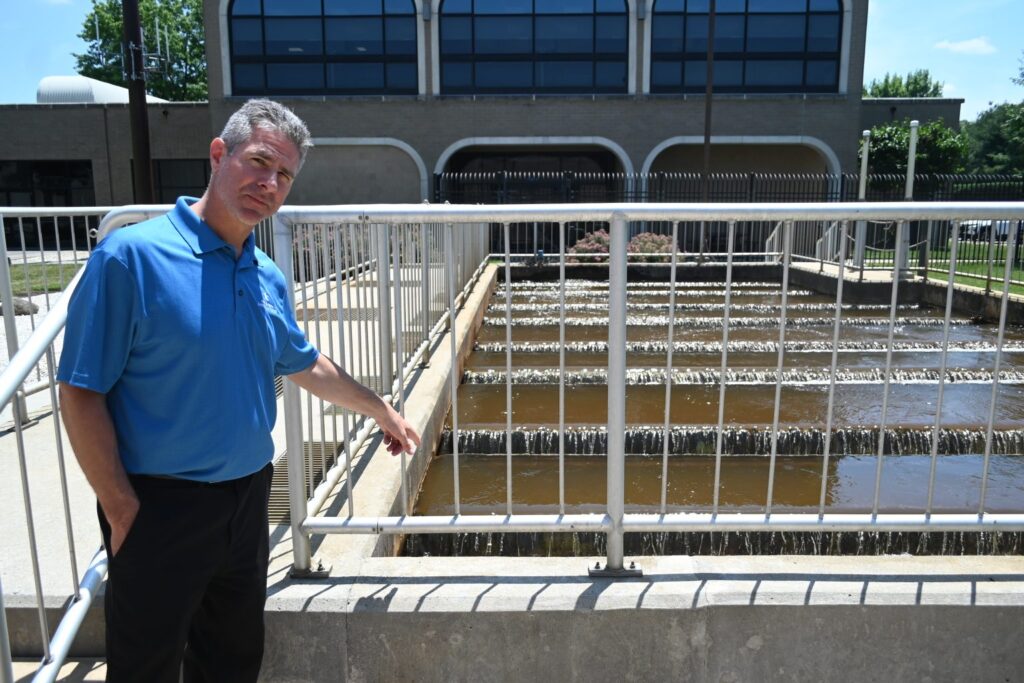South Jersey Information Equity Project: Where Does Your Drinking Water Come From Gloucester, Burlington and Camden Counties?

Greg Rossi, production manager for NJ American Water's southwest operation, in front of the Delran Water Treatment Facility in Delran, N.J. Photo by Emmanuel Young.
By Emmanuel Young | South Jersey Information Equity Project
Editor’s Note: This is the third in a series of articles to educate readers in southwestern New Jersey about the source of their drinking water and its quality. This story was produced as part of the Center for Cooperative Media at Montclair State University’s South Jersey Information Equity Project fellowship and supported with funding from the Independence Public Media Foundation, the Geraldine R. Dodge Foundation and the NJ Civic Information Consortium.
Burlington, Camden and Gloucester Counties in New Jersey are home to many people, farms and businesses that all rely on clean and safe water for everyday purposes. So, where does it come from?
American Water is the country’s most significant water and wastewater utility, offering services to 14 states, including New Jersey. Its New Jersey facilities take water from different resources, such as the Delaware River and groundwater, which is found underground in the cracks and spaces in soil, sand and rock.
Because clean drinking water is a necessity, water treatment facilities follow strict and thorough procedures that are mandated by the state.
The Delaware River Regional Water Treatment Plant, for instance, supplies water from the Delaware River, which is carefully cleaned of all regulated chemicals and harmful bacteria and provided to many areas in South New Jersey.
This treatment facility delivers up to 50 million gallons of water daily and even more during the summer. Because of this enormous task, it is monitored and operated by experienced and licensed professionals.
The facility is designed to clean and filter water and study the bacteria found in it. Because of this crucial task, it uses six steps to filter the water: coagulation, fluctuation, sedimentation, filtration, disinfection and storage water.

Coagulation uses aluminum and iron-based chemicals to bind with water’s dirt and other organic matter. Fluctuation is mixing the water to clump the dirt and form larger particles.
Clarification/sedimentation is the process of the heavy particles settling out, and the clear water flows through. Due to the solid minerals having high nutrients and water-retaining properties, they are recycled and used to improve the quality of top soils.
Filtration filters the water through layers of sand, coal and activated carbon that clears smaller particles still in the water. Disinfection is the final step — a small amount of chlorine is added to kill any bacteria and then the water is stored for the chlorine to finish its work.
The water is then pushed via pipes into communities to fire hydrants, water towers and homes.
So, what are some ways to learn more about what is done to keep water clean and how to take care of it?
For starters, read up on yearly water reports. Every year, American Water and other companies publish a report on the status and findings of the water.

Each report is on the American Water’s state website.
Enter your zip code to see the county or town reports, which are backed by specialists and plant operators who write detailed reports on their processes to keep it clean and provide background data on their research. Also, check the consumer confidence reports from the U.S. Environmental Protection Agency.
Learning more about common contaminants and issues in drinking water, such as PFAs and lead, is essential because there are free programs and information that go into detail about what is done to purify water and remove harmful substances.
Lead has been a concern in drinking water, as corroding pipes leak lead into our drinking water, making it dangerous for consumption.
Some houses, especially older ones, may still have them. They are removed from the household and replaced with safer pipes, such as PEX pipes, commonly used in residential homes. PEX pipes are easier to install and less prone to leakage.
An excellent way to check what pipe you may have is to scratch the pipe with a coin. Depending on the material of the pipe, the coin will show in color — copper for copper pipes, black or blue for plastic, and a dull silver-gray color for galvanized steel.
If corrosion is present in pipes, notify the service line provider and contact a certified plumber to conduct an inspection. You can also self-report this using the water utility’s website.
For more information visit: www.amwater.com.

American Water welcomes visitors to learn first-hand about its processes. Check this link.
Finally, visit a community event. American Water hosts local community information events in certain towns so residents can learn more about their water and where it comes from.
For more information:
Consumer Confidence/Water Quality reports: Water Quality Reports (amwater.com)
South Jersey Water Professionals Association: SJWPA – South Jersey Water Professionals Association
Environmental Protection Agency guidelines and information board: www.epa.gov/environmental-topics/water-topics
American water PFAS/PFOS information: www.amwater.com/njaw/Water-Quality/PFAS
Here’s all of American Waters’ press releases where you can find out about community events as well as advice for possible flooding problems: www.amwater.com/press-room/press-releases/?region=new-jersey.
Follow Us Today On:
Note from AC JosepH Media: If you like this story and others posted on Front Runner New Jersey.com, lend us a hand so we can keep producing articles like these for New Jersey and the world to see. Click on SUPPORT FRNJ and make a contribution that will go directly in making more stories like this available. Thank you for reading!




